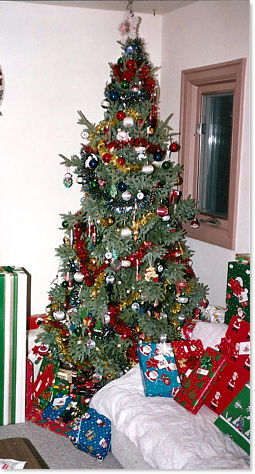
Black Spruce - My Christmas Tree
| By Johnny Caryopsis | (Click links for more images.) |
"OK, OK, OK! Let's go get a Christmas tree!" There's only so much pestering a dad can take.
 The resulting Christmas tree!
The resulting Christmas tree!Come December each year, it's always the same. "When are we gettin' our tree, when are we gettin' our tree?" By the second week of December I usually relent and off we go, Christmas tree hunting. This year was no different. But I'm a city boy, so for me getting a tree has always meant jumping in the car and heading to a local Christmas tree lot, and that's how our family still gets a tree each year. I've thought about doing the "cut your own" thing, but I can never seem to justify taking half a day to drive out into the country to get something that I can get in half an hour in town, and for about the same amount of money.
I've also thought about the notion of killing a tree just to stick the top part of it up as a decoration in our living room for a couple of weeks, and whether or not we'd be better off with an artificial tree. I've listened to the environmental arguments on both sides, and I've considered the practical arguments for both, like cleaning up needles vs. storing a fake tree in it's huge box. But my heart still says, "real tree". The Christmases of my childhood were celebrated around a real tree, which was almost always a black spruce; and every time I experience the scent of a real tree indoors, it takes me back to those days. Christmas is about traditions, after all.
Well at least this year it's not 30 below, so strapping on the car-top carrier was only moderately a pain, and off we went in search of a Christmas tree lot, a cordoned-off section of some shopping mall parking lot, with a flattened forest of trees standing upright in banks of snow. Nowadays I always look for a tree lot operated by some charitable organization. Perhaps that's partly to allay my conscience over using a real tree for Christmas. I further rationalize my environmental concerns by making sure our tree ends up in our local Christmas tree recycling (mulching) program, too.
So we pull up to a likely looking lot and pile out. As usual, by the time I haul out of the car after checking to make sure I had money and rope or bungee cords to secure the tree to the roof, the kids and my wife are in the lot and poking at the trees already.
"Hey, Dad, how about this pine tree!" shouted my eldest."That's not a pine tree, it's a spruce tree," I replied.
"OK, well how about this SPRUCE tree", he belts back, pointing to yet another tree.
"That's a fir tree."
"Huh?" was all I got back this time.
My guys know I'm a stickler for botanical details and even though I knew it wouldn't sink in the first time, I launched into my taxonomy-of-the-coniferae lecture.
"There are several different kinds of trees on this lot. There are black spruce trees, balsam fir trees, Scot's pine trees; and for all I know a couple of other different kinds, as well," I rambled. "Spruce and fir trees have short needles that grow separately around the small branches. Pine trees have long needles that grow in bundles of 2 or more. The needles on fir trees grow out from the sides of the branches, so the whole branch looks flattened. Spruce needles grow out all around the branch, so they look round, like a finger. The pines are all in the Genus: Pinus, the firs are Genus: Abies and the spruces are Genus: Piceae. All these trees are conifers, or evergreen trees, and there are lots of different kinds of each sort of these trees in the world, including 8 species here in Manitoba."
While I was elaborating and pointing out the characteristic features on one of the trees, my kids, and my wife, ducked around to the next aisle of trees, oblivious to my lecture. Oh well, I try.
We finally settled on a nice, plump, 6 foot tall black spruce, after I managed to drag them all away from the $50 "tree-farm-raised Scot's pine" section. The fellow from the lot, who had shown about as much interest in my lecture as my family had, helped us plop the tree on top of the car and bungee-cord it into place. And off we went, having perpetuated another of the season's traditions for yet another year.
Carry on for the Origin of Christmas trees and the Biology of the Black Spruce tree!![]()
| You can help NatureNorth produce more great articles with a secure donation through PayPal. Our Google Adsense ads pay our server costs, but that's about it. To learn more follow this link: Support NatureNorth. Thank-you! | |
Return to: Winter Issue | NatureNorth Front page
